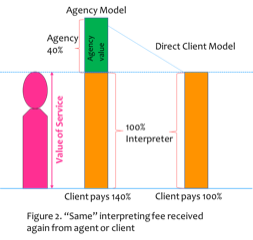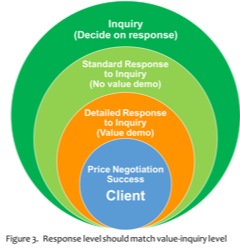Business Aspects to Interpreting for Commerce and Industry: Learning to think like a business owner (Part 2) Value and Pricing
You say: I’m just an individual interpreter who gets almost all of my assignments from a few agencies; I feel more like a hapless laborer with three part-time jobs than an independent business. And my offer to you is this: Are you satisfied with such an arrangement, or do you want to maintain a truly valued business?
As noted in the preface of my first column (Part 1), many interpreters in Japan work predominantly for agencies, who tend to remove the commercial aspect of being an independent professional from the working experience. Instead, the arrangement is psychologically more like an employer and employee. This painted picture can be helpful for people who want to belong and feel lonely or vulnerable as an independent professional. Let the interpreter have the agency fill up a schedule and the economic worry goes away. If the schedule is full, then you must be making money! Except that you’re not an employee, so there is no retirement pension or retirement balloon accruing, and you have to pay all of your own health insurance and national pension premiums. You have to pay for your own office and computer and mobile phone.
Profit and Loss Review
Let’s start with the daily rates for interpreting. This is what we call the top line. Does the agency pay the same full-day rate consistently? If not, why? Do you charge more for interpreting to direct clients than agencies? If not, why? Any time you interpret for a full day below what you consider your “standard” rate, the difference is what we call a discount. If you live far away from Tokyo and the agency doesn’t pay your transportation cost to get to a job, this is a cost to fulfill your daily rates charged for interpreting. Every month your net billings are all of your interpreting charges minus discounts, and gross income is your net sales minus total costs. After you deduct all of your expenses to operate, such as mobile phone, computer, office supplies, office space utilities and occupancy, you pay yourself. Actually, you still have to pay your taxes, health insurance, and pension fund contribution. Then maybe, there is a little left over to save (your profit) after a withdrawal for your regular living expenses. Table 1 shows “who” gets paid before you do. This exercise, which can be repeated and refined for more accuracy, enables the independent interpreter to figure out how much monthly invoicing or revenue (in total yen) yields the necessary net income. Total monthly revenue (yen) will help to establish a fee schedule: what you need to charge for a full day or half-day of interpreting, for example, based on the number of days worked in a month.
Table 1. Monthly Profit and Loss Format for Independent Interpreter
| Standard Description for Industry | Standard Income Statement Terms |
| Total invoicing for interpreting | Gross sales |
| – Reductions (discounts) | – Discounts |
| Net billings | Net sales |
| – Travel, lodging, meals, etc. | – Cost of sales |
| Gross income | Gross income |
| – Business and welfare expenses | – Operating expenses |
| Computer, phone, office, etc. | – Non-operating expenses |
| Insurance, pension, etc. | + Extraordinary income (loss) |
| Net income before taxes | Net income before taxes |
| – Taxes | – Taxes |
| Net income = salary + savings | Net income |
Value of Service
As independent professionals, we are haunted by the phrase “getting paid last.” In the first installment, we talked about factors to differentiate oneself from other interpreters in order to charge a premium fee and to win clients. In this second installment, we focus on purely commercial matters. Do you charge the same fee to direct clients and agencies for similar interpreting assignments? If you do, the following is evident: (1) The agencies are not performing any support work of value, making zero money, and passing through 100% of the fee to you; (2) You are doing more work when serving a direct client for the same amount of money, because there is no agency performing any support work on your behalf. Obviously (1) cannot be true for an agency remaining in existence, while (2) is a commercial failure—except somehow the interpreter suffers through (see Figure 1, “Client pays 60%”)? The key here is the margin (percentage of total amount) that the agency takes versus the value the agency provides. I argue that an agency is perpetually entitled to 10% margin or commission for any job, by virtue of winning the work (successful sales activity). Additional margin is debatable, but any time a lot of human intervention is involved, such as on-site coordinating, equipment arranging, tracking down pre-read materials, etc., the margin should be higher. On the other hand, if it’s a pure hand-off of advising particulars and easy or no pre-read guidance, the margin should be quite small: I suggest an additional 20% on average. That would mean 30% when combined with the 10% sales commission. Unfortunately, the agency also has to pay for its own rent, financial accounting (not the least to ensure payment to interpreters), managers’ salaries and profit (what the business owners earn). If we add 10% for this profit and overhead, we are already at 40%. The cost of doing business is, indeed, high (see Figure 1, “Client pays 100%”).

Two possible insights for Joe or Jane Interpreter here: (1) If the agency is taking 40% of a fee that I’m generating, they’d better be doing a good job and also charging a high fee so that 60% is still plenty for me. (2) Wait a minute, I should be going out and selling directly to recapture the agency margin for myself, because the agency is not coordinating on my behalf very much, and more importantly, selling my services too low for a 60% share to be sufficient. Seth Interpreter can think outside of the box, however: If an agency is really worth its money, it should add value, and therefore, the fee for the same interpreter through an agency should be higher than hiring the interpreter directly (see Figure 2, “Client pays 140%”).

The key difference between Figures 1 and 2 is this: even though the interpreter makes the same fee from direct client or agency in both cases, the interpreter is getting paid fully for his or her value and the agency is earning its own value in Figure 2 under “Client pays 140%.” In Figure 1, the agency, who is not earning any value on its own, relies on the value of service provided by the interpreter. Getting paid as close to full value as possible maximizes your earning, obviously, and is important to pursue as a business.
For a human professional service, however, value is never consistent like a machine that manufactures products of the same shape or size. In the real world, the service provided is subject to performance, which may be affected by the physical condition of the interpreter (e.g., well rested or not), the physical environment of interpreting (too hot or cold), or the physical delivery of service (voice strength), among many other possible factors. Thus, performance may exceed or fall short of the value of service.
Perceived Value, Pricing and Negotiation
In terms of pricing, the illustrations in Figures 1 and 2 are ideal. The client pays a price directly related to the value of service. In the real world, many other factors come into play. Although the industry typically establishes prices for interpreting services according to duration, such as a full day or half-day, the content of such a full day or half-day can vary considerably. The limitless types of meetings and events, the limitless arrangements requested for performing the interpreting, and the limitless types of clients mean that the value perceived for the proper execution of any specific full-day interpreting assignment also varies.
The perceived value for an interpreting assignment is the price a client will readily pay repeatedly for the service. If that value is commoditized with an interpreter stated to be at “equal value” to a certain sizeable number of other interpreters in a pool, the price will likely suffer downward pressure. If that value is emphasized through a selective offer among a limited number of preferred interpreters, the price should maintain a premium. In either case, this initial value perception pertains to the client’s personal economics and has no relation to the interpreter’s fee schedule. The client may or may not be receptive to proposed pricing—here is where the skill of selling gains significance, along with the initial positioning of offered value, which we consider to be part of marketing (topics for future installments).
A low perceived value means the client is prepared to pay a relatively lower price. The offered interpreting fee drops and can be demoralizing to the professional interpreter, although the offer is usually not intended to be a personal judgment. On the other hand, a high perceived value means a relatively higher price, which is possibly motivating. A human interpreter obviously wants to feel valued: the offered price can affect that feeling. The interpreting agency can buffer this situation by negotiating with clients. The negotiation should result in a mutually acceptable price—hopefully higher than the initial client offer. Interpreters who work for the agency can advise an acceptable range of fees upfront to avoid facing the client’s value perception. Hopefully, the negotiation has resulted in a price that is within the fee range of an available interpreter. Otherwise, the agency will have to approach available interpreters to gauge interest for a low-paying assignment. This effort by the agency, however, runs counter to the premise of the interpreters avoiding the “value negotiation” in the first place. Moreover, under the upfront advisement model where interpreters have provided an acceptable range, the agency should have either negotiated a price already known to be acceptable or withdrawn from obtaining the business. But in the real world, there are many other factors involved. The agency perhaps could not refuse the client’s business.
In the same vein, the interpreter eyeing business directly from clients will be required to demonstrate value. Most businesses exist because of rightfully owned, proud value (technology, expertise, for example) that others cannot provide. A low perception of value infringes on this pride. The same situation applies to a professional interpreter. Nonetheless, negotiation may ensue in order to agree on a price. In certain cases negotiation never starts, because the client’s desired price seems too far below the interpreter’s acceptable range. The parties do not expect to reach an agreement and abandon the effort. A successful agreement on price means the interpreter’s value has been sufficiently accepted. For a client with repeating demand for your service, the agreement also represents a promise of future revenues.
To sum up the description above, value relates to price, though negotiation may require the parties to reconsider and allow an adjustment to the initially perceived value and resulting price. Whether the client can “afford to pay” should actually be gauged at the onset before any negotiating. The negotiation over value should be about what the client “agrees to pay.”
In my experience, a client that misleads in the initial discussion frequently fails to bring any work. An independent interpreter engaging directly with a client has limited time to be a salesperson. It is important at an early stage to identify potential clients who are not specifically considering your services. Examples include companies seeking multiple bids without such an explanation, companies with a regular interpreting service provider merely surveying prices on the market to cross-check and use for re-negotiation, and companies wondering about interpreting as a service versus hiring an in-house interpreter. The “value” perspective should aid as a filter (see Figure 3). Cursory inquiries are not gauging your specific value; they are assessing generic value. In such an instance, you do not want to share much information about pricing, because you have not demonstrated your value yet. For a professional service, value should be demonstrated after specific interest is shown, with a final stage of quotation and negotiation to reach an acceptable price.

Abstract Forces
Interpreting to a certain extent is abstract. The client is not buying a specific quantity of widgets for a specific price. An assignment delivers a solution, where communication between two different languages is enabled for an agreed time slot. Client satisfaction is subjective: the interpreting work is ordinarily considered sufficient, if the interlingual communication proceeds smoothly and the business goals set forth for the time slot are completed.
While delivering the solution, one interpreter may have ways to provide more perceived value to the client than another interpreter. At a more detailed level, an interpreter may exhibit more perceived value to a client through certain actions rather than others during the assignment. Efforts to enhance perceived value are probably worthwhile. In any event, the interpreter should wisely consider the performance as “proof” to the value proposed in the agreed price of an assignment. For an existing client as well, steady performance is the only course for best position in continuing business. Whenever performance suffers, the delivered value falls short of the promise, and the client will notice. This performance problem may not be directly related to the interpreter or interpreter’s skill. Nonetheless, when an accumulated shortfall in value becomes apparent, wise client relations suggest making up for the deficit. The remedy does not necessarily need to be monetary in terms of a refund or discount, although business people find commercial adjustments easy to follow. In my experience, providing some extra service future-forward at no charge benefits both parties and strengthens the relationship.
Full Circle
For a professional interpreter, the profit/loss format (Table 1) shows how much total invoicing or revenue (yen) can be targeted every month for certain net income. The values offered for actual interpreting and business peripheral to interpreting need to combine coherently. The value of the interpreting agency is in play, just like the value of the interpreter (Figures 1 & 2). The client’s “perceived value” for the interpreting service (as a whole) relates to price. Negotiating may be required in order to reach a mutually acceptable price. The interpreting agency can negotiate for interpreters less inclined to handle the task. Actual interpreting work is somewhat abstract, and its perceived value can consequently be affected when interpreting performance suffers. Making up for a deficit in performance is positive for the client relationship. Managing these ongoing value equations, therefore, become a way to retain valued relations and to re-examine relations out of balance. The requisite skill is correctly ascertaining the client relationship in terms of the perceived value for what is provided.

Raised in Japan, the US and briefly in Indonesia, Reames started translating professionally during his college education years, including a stint for one year at a translation company in Japan. An undergraduate degree in chemistry (1988) laid a bedrock of technical knowledge in material and molecular science, chemical engineering, semiconductors, nuclear energy, computing and telecommunications. He has over 30 years of experience as a J>E and E>J translator; conference, simultaneous, consecutive, and deposition E<>J interpreter; and business owner offering translation and interpreting services. Principal fields of practice include legal, technical, commercial, and financial aspects of future automotive, mobile communications, fast-moving consumer goods, steel manufacturing, luxury goods, retail and wholesale distribution, and fintech. Currently a certified member of JACI, past member of JAT, past active member and former treasurer of the ATA, and previously an ATA-certified translator for both English to Japanese and Japanese to English.